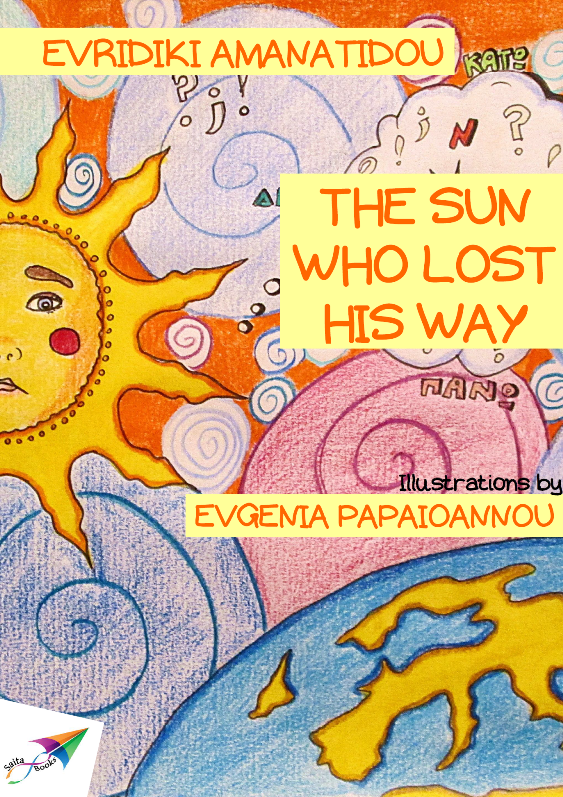Our third educational program is dedicated to the
fairytale “The Sun Who Lost His Way” by Evridiki Amanatidou with illustrations
by Eugenia Papaioannou. It is for students aged 6-10, the duration time is
45-50 minutes and the suggested number of participants is 20-25 children.
Program Outline
1. Presenting Saita Publications and
their vision for the free travel of books.
2. Presenting the fairytale, “The Sun
Who Lost His Way” with the participation of the children.
3. Creating handcrafts with the theme
“Making a holiday garland for Shiny”
1. Presenting Saita Publications and
their vision for the free travel of books.
There are two countries, one is Fantasia (Imagination)
which has house full of fairytales, and the other country is Reality, which is
the homes we live in, here in our town. Somewhere there in between the two
countries, up on a tall hill, our “saita” (paper plane) landed (you may create
your own saita with the four colors from our publications’ logo or click on our
website from your computer screen). The “saita” picked this spot to land
because it was too windy over there. It made the windmill, which you see (you
may either buy or make your own colorful windmill), and as the windmill turns
against the wind, so does our imagination, which helps us create beautiful
stories. The creativity is always awake, and it “nudges” the imagination into
creating new things. Did you catch a glimpse of its wings? How many colors did
you see? We will be painting much more with our stories today.
2. Presenting the fairytale “The Sun
Who Lost His Way” with the participation of the children.
A Power Point presentation may also be used, aside
from the pdf file of the book, which will only have the illustration of the
fairytale. The second choice demands greater confidence and a better
presentation, but the first one is “safer”. In both choices, the presentation
should be done with the children, and not just for the children. With the
questions they ask about the storytelling, the children both expand their
imagination and gain an understanding of the progress in the plot. We also try,
through the points offered (points of the Horizon, page 7) to “awaken” the
narration, urging the children to create, by using their bodies, an imaginary,
big compass and to follow our requests according to the position they take. For
example: “The children who are wearing green clothes can move to the North” or
“Those of you that are tall, stand facing the East”. The presentation only
continues when they have located their seats. This short game can be combined
with other points of the text, for example in Shiny’s question “What have I
learned about where “left” and “right” is? Where am I standing now? In the
South or in the North?”, and that can be found in page 9. We ask the children
and they answer. Another point added to “awaken” the narration is the signs,
which are placed by the citizens in order for Shiny to find his way back home,
which can be found on page 13. We then form a trail between the signs, which
inform us about the avenues and numbers. Aren’t they important to us so we can
communicate with each other, so we will not lose our way? We should be careful
and maintain the children’s interest but also attention, so we will not
overstay with the specific part of the presentation, and we will take care to
stay within a certain time frame. We want the biggest part of the whole action
to be devoted to the game and the activities, and not the presentation.
3. Creating handcrafts with the theme
“I make a holiday garland for Shiny”
After the adventure he has had, and a little help from
the citizens, Shiny finally finds his way back home. We should celebrate! For
the occasion, the children are asked to create a festive garland, which will
decorate their classroom, with many different suns.
-We ask them to sit in a circle (on the floor or
around a big table). In the center of it we place the colored papers, the
cardboards of different dimensions, the colored pencils, the eraser, and the
scissors, the glue (stick), and the yellow and orange highlighters, and the
ribbons.
-We ask each child to think of and create their own
unique sun. We take extra care with the scissors. If the children should wish
to cut something with the scissors, then they have to ask us. None of the
children shall use the scissors, except us!
-As soon as they finish their sun creations, we use a
big piece of string to hang the suns up.
-We congratulate them on their beautiful garland which
they have created.
Translation: Metaxia Tzimouli
Editing: Tina Moschovi

No comments:
Post a Comment